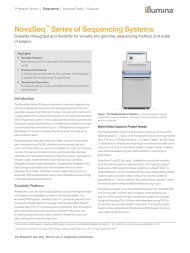Abstracts
ngsfinalprogram
ngsfinalprogram
You also want an ePaper? Increase the reach of your titles
YUMPU automatically turns print PDFs into web optimized ePapers that Google loves.
Poster <strong>Abstracts</strong><br />
evolution. Determining which lineages are<br />
present throughout Italy is crucial to understanding<br />
brucellosis epidemiology as well as to<br />
place Italian samples into a global evolutionary<br />
context. The aim of this study was to evaluate<br />
an NGS approach using different analyses<br />
to investigate B. melitensis diversity in Italy.<br />
Previous genetic assessment using variable<br />
number tandem repeats (VNTRs) revealed the<br />
presence of the west Mediterranean lineage<br />
structured in several clades that were sometimes<br />
geographically constrained. We selected<br />
16 B. melitensis isolates for whole genome<br />
sequencing representing maximum genetic and<br />
geographic diversity. Libraries were sequenced<br />
with both paired-end Illumina and Ion Torrent<br />
sequencing, and our analyses included 59<br />
publicly available B. melitensis genomes. We<br />
performed SNP analysis in read alignments<br />
and whole genomes using NASP pipeline, and<br />
in parallel we applied a gene-based approach<br />
using MLST+. Approximately 22,000 putative<br />
SNPs were identified among the B. melitensis<br />
samples. The MLST+ revealed 1,748 targets<br />
for the first chromosome and 876 targets for<br />
the second chromosome totaling 2,624 loci.<br />
Both approaches found that the Italian isolates<br />
formed 3 sub-clades as part of the B. melitensis<br />
strain Ether lineage, a strain that was isolated<br />
in Italy fifty years ago, suggesting that this<br />
lineage has been well established and successful<br />
for at least over half century in the Italian<br />
peninsula. Finally, we compared our results to<br />
a recently published shotgun metagenomic B.<br />
melitensis sequence from bones from a medieval<br />
grave in Sardinia (Italy) and confirm that<br />
this same lineage has been present in the region<br />
for centuries. This study is a step forward<br />
in understanding of Brucella evolution in the<br />
Mediterranean area, and demonstrates the utility<br />
of WGS SNP analysis, and the feasibility<br />
of MLST+ as a fast and reliable typing system<br />
for analyzing the epidemiology of Brucella in<br />
endemic regions.<br />
n 41<br />
GENOMIC EPIDEMIOLOGY AND<br />
TRANSMISSION OF SALMONELLA<br />
CHOLERAESUIS VAR. KUNZENDORF IN<br />
EUROPEAN PIGS AND WILD BOAR<br />
P. Leekitcharoenphon, F. M. Aarestrup, R. S.<br />
Hendriksen;<br />
Technical University of Denmark, Kgs. Lyngby,<br />
DENMARK.<br />
Salmonella Choleraesuis is a relative infrequent<br />
serovar adapted to pigs but also have a<br />
propensity to cause extraintestinal infections<br />
in humans. S. Choleraesuis var. Kunzendorf<br />
are responsible for the majority of outbreaks<br />
among pigs. The global transmission was<br />
believed to be a result of imported breeding<br />
pigs from Canada and the USA into Taiwan.<br />
In Europe, S. Choleraesuis is a relatively rare<br />
serovar, both in slaughter pigs and in breeding<br />
herds. In Denmark, only a few outbreaks have<br />
been reported among pig herds within the last<br />
decade; 1999 - 2000 and 2012 - 2013 and in<br />
both cases it has been impossible to identify<br />
the route of transmission and source of infection.<br />
In order to understand transmission and<br />
epidemiology of S. Choleraesuis, we have<br />
sequenced 108 S. Choleraesuis isolates from<br />
pig and wild boar from 12 European countries<br />
and USA. We applied SNP-based phylogenetic<br />
methods based on whole genome sequences to<br />
identify the population structure. We used Baysian<br />
phylogeny to estimate dates of divergence<br />
and phylogeographic analyses of lineages by<br />
using BEAST with Bayesian Skyline model of<br />
population size change and relaxed uncorrelated<br />
lognormal clock as the molecular clock.<br />
The S. Choleraesuis isolates yielded 2,428<br />
SNPs. We estimated that the ancestral emergence<br />
of S. Choleraesuis was in 1946. The<br />
mean evolutionary rates were approximated to<br />
be 1.58 x 10-6 SNPs/site/year corresponding<br />
to 7.5 SNPs/year. The isolates were divided<br />
into two complex clusters and they resided<br />
in sub-clusters according to countries and<br />
neighbour countries of isolation. According to<br />
the source of isolation, the wild boar isolates<br />
ASM Conference on Rapid Next-Generation Sequencing and Bioinformatic<br />
Pipelines for Enhanced Molecular Epidemiologic Investigation of Pathogens<br />
67



